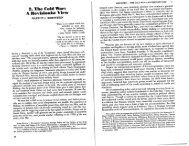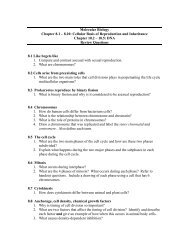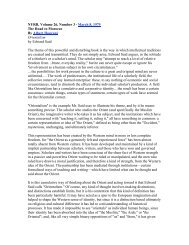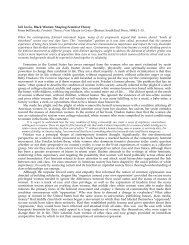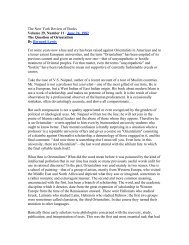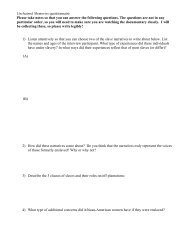fieldston american reader volume i â fall 2007 - Ethical Culture ...
fieldston american reader volume i â fall 2007 - Ethical Culture ...
fieldston american reader volume i â fall 2007 - Ethical Culture ...
- No tags were found...
Create successful ePaper yourself
Turn your PDF publications into a flip-book with our unique Google optimized e-Paper software.
to the interior & landed interest,” Madison quoted him,will he foresees be such an oppression of commerce, that he shall beobliged to vote for ye. vicious principle of equality in the 2d. branchin order to provide some defence for the N. States agst. it.“It has been said,” Morris added, “that N.C. [,] S.C. and Georgiaonly will in a little time have a majority of the people in America.They must in that case include the great interior Country, andevery thing was to be apprehended from their getting the powerinto their hands.”This false expectation explains why Georgia and the Carolinaswho (as Gunning Bedford noted) should by present populationhave been “small” states, considered themselves “large” states atthe Convention. This expectation clarifies, it seems to me, whythe South gave way in its demand that commercial laws require atwo-thirds majority; for would not time and the flow of migrationsoon provide such a majority without written stipulation? At thecrucial Virginia ratifying convention no one questioned that theSouth would soon be the most populous section of the country.The difference lay between those who thought this inevitableevent made it safe to strengthen the Federal government now,and those, like Henry and Mason, who counseled waiting untilthe Southern Congressional majority made absolutely safe atransfer of power.The irony, of course, was that the expectation was completelyerroneous. The expected Southern majority in the House nevermaterialized, and the Senate, not the House, became the bulwarkof the South. In 1790, the population of the South had beengrowing more rapidly than the North’s population for severaldecades, and was within 200,000 of the population north of thePotomac. True to the general expectation in 1787, the Southwestfilled up more rapidly than the area north of the Ohio River. In1820, Ohio, Indiana, Illinois, and Michigan contained a populationof almost 800,000, but Missouri, Kentucky, Tennessee,Alabama, Mississippi, Louisiana, and Arkansas held over1,300,000 persons. Nevertheless, in the original thirteen statesthe Northern population pulled so far ahead of the Southern thatin 1820 the white population of Northern states and territorieswas almost twice that of Southern states and territories. Thusthe South never obtained the Congressional majority whichstatesmen of both sections had anticipated at the time of theConstitutional Convention.When the dream of a Southern majority in Congress and thenation collapsed, there fell together with it the vision of a Southerncommercial empire, drawing the produce of the West down thePotomac and the James to “a Philadelphia or a Baltimore” on theVirginia coast. It was not, as it so often seems, an accident thatthe Convention of 1787 grew from the Annapolis Convention,or that Virginians were the prime movers in calling both.Throughout the 1780’s Madison, Jefferson, Monroe, and to analmost fanatical degree, Washington, were intent on strengtheningthe commercial ties between Virginia and the West. Asearly as 1784, Jefferson suggested to Madison cooperation withMaryland in opening communication to the West, and duringthat year and the next both Washington and Monroe toured theWestern country with their grand plan in mind. Jefferson andMonroe pushed a Potomac location for the national capital partlywith the hope that it would “cement us to our Western friendswhen they shall be formed into separate states” and help Virginiato beat out Pennsylvania and New York in the race for Westerntrade. Virginia had given up its claims to Western land, but itsleaders hoped for a commercial dominion just as satisfactory: asJefferson put it, “almost a monopoly of the Western and Indiantrade.” “But smooth the road once,” wrote the enrapturedWashington, “and make easy the way for them, and then seewhat an influx of articles will be poured upon us; how amazinglyour exports will be increased by them, and how amply we shallbe compensated for any trouble and expense we may encounterto effect it.” The West, then, would not only give the Southpolitical predominance but also, as Madison wrote Jefferson,“double the value of half the land within the Commonwealth ...extend its commerce, link with its interests those of the WesternStates, and lessen the immigration of its Citizens.” This was thecastle-in-the-air which Virginians pictured as they worked tobring about the Constitutional Convention, this was the plan foreconomic development so abruptly and traumatically shatteredby Secretary of the Treasury Alexander Hamilton.In the Spring and Summer of 1788, however, as the South withthe North moved to ratify the Constitution, few foresaw theclouds on the horizon. The Constitutional Convention, with aSouthern majority (in Bancroft’s words) “from its organizationto its dissolution,” seemed to have wrought well for the South.Madison alone, from his vantage-point in Congress, frettedabout that body’s continued preoccupation with sectional issues.After wrangling all Spring about the admission of Kentucky,Congress turned to that old favorite, the location of the capital.“It is truly mortifying,” Madison wrote to Washington, to seesuch “a display of locality,” of “local and state considerations,”at the very “outset of the new Government.” The behavior ofCongress would give “the most popular arguments which havebeen inculcated countenance to some of federalists,” and “beregarded as at once a proof by the southern antipreponderancyof the Eastern strength.” “I foresee contentions,” he wrote thenext Spring, “first between federal and anti-federal parties, andthen between northern and southern parties.” Before long hewould be leading the opposition.VEven this sampling of the printed sources suggests thatsectional conflict based (to quote Madison once more) on “theinstitution of slavery and its consequences” was a potent forcein the shaping of the Constitution. The conclusion seemsinescapable that any interpretation of the Convention whichstresses realty and personalty, large states and small states,or monarchy and democracy, but leaves slavery out, is aninadequate interpretation.187



